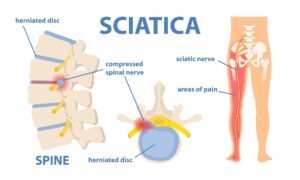 If you’re currently experiencing sciatica, you likely already know how disruptive it can be to your everyday life. And you’re likely all too familiar with common sciatica symptoms—like lower back, hip, and leg pain and numbness or tingling that extends through the buttocks and down the legs.
If you’re currently experiencing sciatica, you likely already know how disruptive it can be to your everyday life. And you’re likely all too familiar with common sciatica symptoms—like lower back, hip, and leg pain and numbness or tingling that extends through the buttocks and down the legs.
The good news is that physiotherapy can both prevent and relieve these symptoms. Through an all-natural approach, a physiotherapist provides manual therapies, exercises, and more to help you get back to your normal. So, let’s take a closer look. How can physiotherapy help exactly? And what causes sciatica in the first place?
What Is Sciatica?
Sciatica occurs due to inflammation or pinching of the sciatic nerve. Sometimes, this happens because of a herniated disc, bone spurs, tight muscles, or, sometimes, even health issues—such as a tumor or diabetes.
And not every case is debilitating. For some, sciatica may cause only mild discomfort. Yet, for others, it can severely limit their daily activities.
Either way, seeking out professional help can ensure you reduce or eliminate your symptoms, as well as prevent future flare-ups. Below, we dive into how physiotherapy can be part of your treatment and preventative strategy.
Physiotherapy and Sciatica: Can It Help?
Physiotherapy approaches sciatica by alleviating the cause of the irritation. In other words, the goal is to reduce the pressure on the sciatic nerve, leading to sciatica signs and symptoms. A physiotherapist also works with you to restore function and mobility, helping you get back to the activities you love.
So, let’s break this down further. How exactly can physiotherapy reduce sciatica? What should you know?
1. Manual Therapy
Manual therapy for sciatica includes a range of methods, such as:
- Spinal mobilisations: This technique works to restore range of motion and function to the affected joints. In the case of sciatica, spinal mobilisation desensitises the sciatic nerve, improves nervous system function, and promotes soft tissue healing.
- Mechanical traction: This is a useful manual therapy technique for those with herniated or bulging discs as well as spinal stenosis impacting the sciatic nerve. Mechanical traction works to create space between the vertebrae joints, alleviating the pressure on the nerve.
- Joint and tissue mobilisations: These techniques aim to alleviate tension and pain in the soft tissues of the body, helping you move and function better.
Ultimately, your physiotherapist determines what techniques are best for you. At your initial physiotherapy appointment, you undergo a thorough assessment, which helps determine your unique treatment plan.
2. Prescribed Exercises & Stretches
Depending on your initial assessment, your physiotherapist prescribes exercises such as:
- Postural correction exercises
- Core strengthening exercises
- Leg strengthening and stretching exercises
- Back stretches
The goal of these exercises is to increase blood flow, reduce pain, alleviate tension, and enhance overall body strength and function.
Your physiotherapist may further make lifestyle recommendations, including:
- Avoiding bending forward
- Limiting your time sitting or taking frequent breaks
- Maintaining proper posture throughout your day
- Ensuring your mattress and pillow provide optimal comfort
- Maintaining a healthy body weight
- Using proper lumbar supports when sitting
3. Dry Needling
Dry needling uses sterile needles to decrease pain, enhance mobility, and improve range of motion. Many people often report immediate relief after the first session. With Turramurra Sports & Spinal Physiotherapy, your physiotherapist will determine whether this modality makes sense for you.
Are you currently experiencing back or sciatic pain? Together, we can help you find a path forward. The Turramurra Sports & Spinal Physiotherapy team can not only guide you toward pain relief but also help prevent future sciatica symptoms. Book your appointment through our online portal today or call (02) 9144 1510 to speak to a member of our team.











